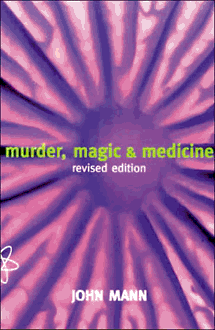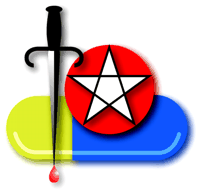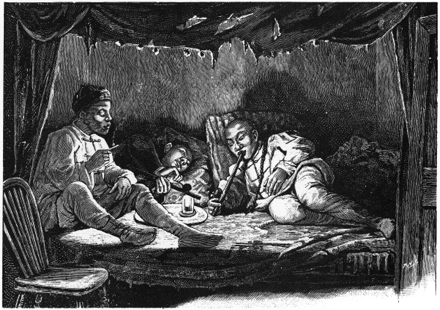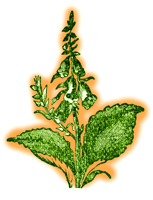For Killers, Conjurers, and Curers
- Christine K. Carrico, Ph.D.

Double, double toil and trouble;
Fire burn and cauldron bubble.
Fillet of a fenny snake,
In the cauldron boil and bake:
Eye of newt, and toe of frog,
Wool of bat, and tongue of dog,
Adder's fork and blind-worm's sting,
Lizard's leg, and howlet's wing,
For a charm of powerful trouble,
Like a hell-broth boil and bubble.
Double, double toil and trouble;
Fire burn and cauldron bubble.
Scale of dragon, tooth of wolf
Witches' mummy, maw and gulf
Of the ravin'd salt-sea shark
Root of hemlock digg'd i' the dark…
Shakespeare, MacBeth

The above quotation from MacBeth sets a poetic tone for the opening to John Mann's Murder, Magic and Medicine. The introduction, however, quickly segues into a concise but lucid primer of basic neuropharmacology and signal transduction for the non-pharmacologist. This prelude is followed by an absorbing and detailed history of the evolution of pharmacology from its roots in herbal and folk medicine.
In Chapter 1, Mann chronicles the murderous use of plant and animal products around the world and through the ages. Plant poisons, such as the sap of the upas tree and physostigmine, are discussed in the context of hunters' arrows, executions, and trial by ordeal. Marine toxins, amphibian toxins, microbial toxins, and mycotoxins are all covered in detail, as are the more traditional poisons, hemlock, aconite, and arsenic. The chapter is divided into sections that not only cite historical and literary documentation of poisonous practices, but also offer pharmacological explanations that relate the observed effects of agents, traditionally exploitaed as poisons, to their potential application as therapeutics.
The second chapter, “Magic,” reverses this approach by tracing the history of substances from folk medicine, traditionally intended for therapeutic uses, to their more recent exploitation as stimulants, psychomimetics, and inebriants. Within these three categories, the author discusses everything from coffee and tea to ibogaine and peyote. The history covered in this chapter is truly fascinating. The stimulant properties of cocaine, for example, have been known since at least 500 ad. Most pharmacology graduate students have heard the story that Coca Cola originally contained coca, but Mann recounts the lesser known fact that coca extract was made into wine and lozenges in Italy, and was sanctioned by Pope Leo XIII (1810-1903). Given the current notoriety of cocaine, it is interesting to read that, “at the present time, we can thus view at least 1500 years of Indian culture based upon coca, about 100 years of clinical utility, and perhaps ten to fifteen years of serious drug abuse, all dependent upon the same stimulant, cocaine.”
Amanita muscaria is discussed in great depth, from its probable identity as the source of soma, Aldous Huxley's social drug in Brave New World, to the basis of Alice's hallucinations in Alice in Wonderland, to the source of energy and drive for the Norse berserkers in early times. Witches' brews, hashish, and a smorgasbord of new-world psychotomimetics, such as ayahuasca and peyote, are all touched upon. Even the humble nutmeg merits discussion for its mild intoxicative properties, the source of which isn't really known. The section on inebriants focuses mostly on different wines and beers, and after reading about primitive methods of alcoholic fermentation, you may never look at a beer quite the same again. An excellent discussion of the history and effects of absinthe ends the chapter on “Magic.”

Almost half the book is devoted to “Medicine.” Starting with a section on the history of pharmacy, from the earliest systematic study of herbal medicine by the Emperor Shennung in 2700 bc to today, Mann explores the many classes of therapeutics, including: antibacterial substances; anti-inflammatory agents; drugs affecting the reproductive system, the heart, and circulation; drugs affecting the central nervous system; anti-asthma drugs; drugs affecting the gastrointestinal tract; antiparasitic agents; and anticancer drugs. Each section starts with a fairly easy-to-understand description of the physiology underlying the pharmacology. ”Medicine” is really a history of drug discovery and places herbal medicine, medicine, and pharmacology within the greater, historical geo-politico-religious context. Detailed accounts are provided on the discovery of penicillin and other antibiotics, aspirin, digitalis, opium (and heroine), tobacco, and quinine, to name a few. Familiar names, such as John Jacob Abel, K.K. Chen, Sir James Black, Louis Goodman, and Alfred Gilman appear in this chapter.

The book is liberally illustrated with photographs and detailed pen-and-ink drawings of many plant culprits, as well as pharmacological cartoons to help the non-pharmacologist understand the effects being described. John Mann is a Professor of Organic Chemistry at the University of Reading, and his book was first published in 1992, updated in 1994 (basis of this review), and a new version, published in 2000, expands the third chapter (“Medicine”) to include newer drugs such as AZT and Prozac. Although not a quick read, this is a very captivating book, and one that you will probably want to refer to frequently, if for no other reason than to provide cocktail party conversation. (“Say, did you know that that martini you are drinking had its origins in 77 ad for the treatment of creeping ulcer?”)

- © American Society for Pharmacology and Experimental Theraputics 2001



